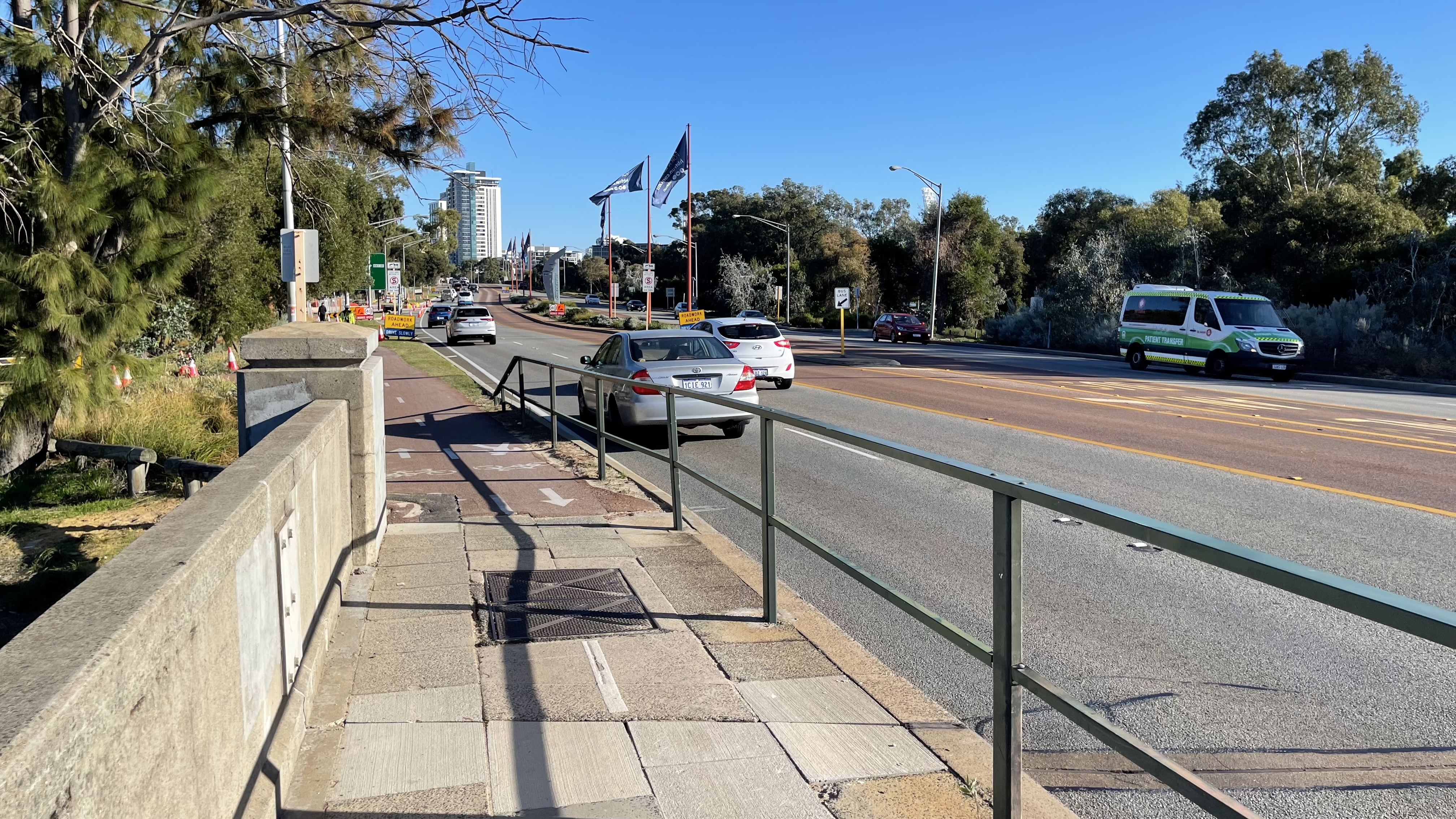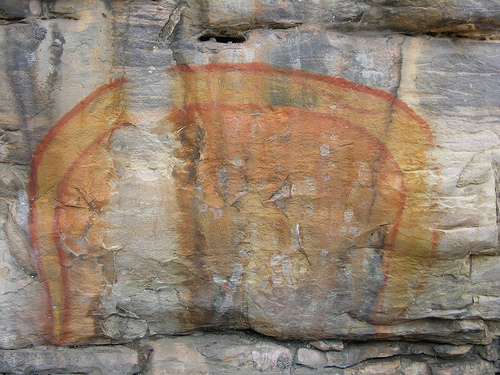|
Boorloo Bridge
Boorloo Bridge is a pedestrian and cycle crossing comprising two cable-stayed bridges about apart that span two separate channels of the Swan River (Western Australia), Swan River in Perth, Western Australia. These two bridges are connected by the footpath, pedestrian and bike path, cycle path across Heirisson Island that they carry to the East Perth and Victoria Park, Western Australia, Victoria Park foreshores. The crossing facilitates the linking of the East Perth side of the river with the Victoria Park side, and is located slightly downstream of the Causeway, the existing road crossing between the East Perth and Victoria Park sides across the island also carried over the river by two bridges. Construction began in March 2023, and the two bridges were opened on 22 December 2024. The project was known during construction as the Causeway Pedestrian and Cyclist Bridges and was later named Boorloo Bridge (wikt:Special:Search/singular , singular) after the Noongar name for Perth, ... [...More Info...] [...Related Items...] OR: [Wikipedia] [Google] [Baidu] |
Footpath
A footpath (also pedestrian way, walking trail, nature trail) is a type of thoroughfare that is intended for use only by pedestrians and not other forms of traffic such as Motor vehicle, motorized vehicles, bicycles and horseback, horses. They can be found in a wide variety of places, from the centre of cities, to farmland, to mountain ridges. Urban footpaths are usually paved, may have steps, and can be called alleys, lanes, steps, etc. National parks, nature preserves, conservation areas and other protected wilderness areas may have footpaths (trails) that are restricted to pedestrians. The term 'footpath' includes pedestrian paths that are next to the road in Hiberno-English, Irish English, Indian English, Australian English, and New Zealand English (known as 'pavement' in the British English and South African English, or sidewalk in North American English). A footpath can also take the form of a footbridge, linking two places across a river. Origins and history Public ... [...More Info...] [...Related Items...] OR: [Wikipedia] [Google] [Baidu] |
Heirisson Island
Heirisson Island is an artificially created island in the Swan River in Western Australia at the eastern end of Perth Water, within the suburb of East Perth. It occupies an area of , and is connected to the two foreshores by the Causeway and the Boorloo Bridge. The next upstream island is Kuljak Island, then Ron Courtney Island, with no islands in the Swan River downstream between Heirisson Island and the Indian Ocean other than the artificial islet in Elizabeth Quay. Before development, there were several small islands, surrounded by mudflats. Over the years, dredging and reclamation has created a single island, which is now a landscaped nature reserve, with a walking path. The Noongar name for the area is (meaning 'leg deep'), which has been retained for the single island after reclamation. Heirisson Island is listed on the Western Australia Department of Aboriginal Affairs' Register of Aboriginal Sites, as ID 3589. History Heirisson Island originally consisted of ... [...More Info...] [...Related Items...] OR: [Wikipedia] [Google] [Baidu] |
Stay Cable
Steel wire rope (right hand lang lay) Wire rope is composed of as few as two solid, metal wires twisted into a helix that forms a composite ''rope'', in a pattern known as ''laid rope''. Larger diameter wire rope consists of multiple strands of such laid rope in a pattern known as ''cable laid''. Manufactured using an industrial machine known as a strander, the wires are fed through a series of barrels and spun into their final composite orientation. In stricter senses, the term ''wire rope'' refers to a diameter larger than , with smaller gauges designated cable or cords. Initially wrought iron wires were used, but today steel is the main material used for wire ropes. Historically, wire rope evolved from wrought iron chains, which had a record of mechanical failure. While flaws in chain links or solid steel bars can lead to catastrophic failure, flaws in the wires making up a steel cable are less critical as the other wires easily take up the load. While friction between the in ... [...More Info...] [...Related Items...] OR: [Wikipedia] [Google] [Baidu] |
Boomerang
A boomerang () is a thrown tool typically constructed with airfoil sections and designed to spin about an axis perpendicular to the direction of its flight, designed to return to the thrower. The origin of the word is from Australian Aboriginal languages, an Aboriginal Australian language of the Sydney region. Its original meaning, which is preserved in official competitions, refer only to returning objects, not to throwing sticks, which were also used for hunting by various peoples both in Australia and around the world. However, the term "non-returning boomerang" is also in general use. Various forms of boomerang-like designs were traditionally and in some cases are still used by some groups of Aboriginal Australians for hunting. The tools were known by various names in the many Aboriginal languages prior to Colonisation of Australia, colonisation. The oldest surviving Aboriginal boomerang, now held in the South Australian Museum, was found in a peat bog in South Australia, d ... [...More Info...] [...Related Items...] OR: [Wikipedia] [Google] [Baidu] |
Digging Stick
A digging stick, sometimes called a yam stick, is a wooden implement used primarily by subsistence-based cultures to dig out underground food such as roots and tubers, tilling the soil, or burrowing animals and anthills. It is a term used in archaeology and anthropology to describe similar implements, which usually consists of little more than a sturdy stick which has been shaped or sharpened and sometimes hardened by being placed temporarily in a fire. Fashioned with handles for pulling or pushing, it forms a prehistoric plough, and is also described as a type of hoe. Digging sticks more than 170,000 years old, made of boxwood by Neanderthals, have been found in Italy. By region Americas In Mexico and the Mesoamerican region, the digging stick was the most important agricultural tool throughout the region. The ''coa'' stick normally flares out into a triangle at the end and is used for cultivating maize. It is still used for agriculture in some indigenous communities, ... [...More Info...] [...Related Items...] OR: [Wikipedia] [Google] [Baidu] |
Australian Aboriginal Religion And Mythology
Australian Aboriginal religion and mythology is the sacred spirituality represented in the stories performed by Aboriginal Australians within each of the language groups across Australia in their ceremonies. Aboriginal spirituality includes the Dreamtime (''the Dreaming''), songlines, and Aboriginal oral literature. Aboriginal spirituality often conveys descriptions of each group's local cultural landscape, adding meaning to the whole country's topography from oral history told by ancestors from some of the earliest recorded history. Most of these spiritualities belong to specific groups, but some span the whole continent in one form or another. Antiquity An Australian linguist, R. M. W. Dixon, recording Aboriginal myths in their original languages, encountered coincidences between some of the landscape details being told about within various myths, and scientific discoveries being made about the same landscapes. In the case of the Atherton Tableland, myths tell of the o ... [...More Info...] [...Related Items...] OR: [Wikipedia] [Google] [Baidu] |
Rainbow Serpent
The Rainbow Serpent or Rainbow Snake is a common deity often seen as the Creator deity, creator God, known by numerous names in different Australian Aboriginal languages by the many List of Australian Aboriginal group names, different Aboriginal peoples. It is a common Motif (visual arts), motif in the art and religion of many Aboriginal Australian peoples. Much like the archetypal mother goddess, the Rainbow Serpent creates land and diversity for the Aboriginal people, but when disturbed can bring great chaos. There are many names and stories associated with the serpent, all of which communicate the significance and power (sociology), power of this being within Australian Aboriginal religion and mythology, Aboriginal mythology, which includes the worldview commonly referred to as The Dreaming. The serpent is viewed as a giver of life through its association with water, but can be a destructive force if angry. The Rainbow Serpent is one of the most common and well-known Aborigin ... [...More Info...] [...Related Items...] OR: [Wikipedia] [Google] [Baidu] |
Wagyl
The Wagyl (also written Waugal, Waagal, and variants) is the Noongar manifestation of the Rainbow Serpent in Australian Aboriginal religion and mythology, from the culture based around the south-west of Western Australia. The Noongar describe the Wagyl as a snakelike Dreaming creature responsible for the creation of the Swan and Canning rivers and other waterways and landforms around present day Perth and the south-west of Western Australia. The Wagyl stories may represent the survival in oral tradition of extinct Australian megafauna, as there was a python-like snake, '' Wonambi naracoortensis'', with a length of . Name Due to the Noongar language having several dialects, the Wagyl is referred to by different groups by different names. Varieties include , , , , , , , , and . In the Wiilman Noongar dialect, the Wagyl is called the (meaning 'hairy-faced snake'). Mythology In Noongar mythology, stories about the Wagyl vary among the 14 different Noongar groups. Some gro ... [...More Info...] [...Related Items...] OR: [Wikipedia] [Google] [Baidu] |
PerthNow
''The Sunday Times'' is a tabloid Sunday newspaper published by Seven West Media, in Perth and distributed throughout Western Australia. Founded as ''The West Australian Sunday Times'', it was renamed ''The Sunday Times'' from 30 March 1902. Owned since 1955 by News Limited, the newspaper and its website ''PerthNow'', were sold to Seven West Media in 2016.SWM finalises purchase of The Sunday Times . '''', 8 November 2016, page 3 History Established by Frederick Vosper and E ...[...More Info...] [...Related Items...] OR: [Wikipedia] [Google] [Baidu] |
Weathering Steel
Weathering steel, often referred to by the genericised trademark COR-TEN steel and sometimes written without the hyphen as corten steel, is a group of steel alloys that form a stable external layer of rust that eliminates the need for painting. U.S. Steel, U.S. Steel (USS) holds the Trademark, registered trademark on the name COR-TEN. The name COR-TEN refers to the two distinguishing properties of this type of steel: corrosion resistance and tensile strength. Although USS sold its discrete plate business to International Steel Group (now ArcelorMittal) in 2003, it makes COR-TEN branded material in strip mill plate and sheet forms. The original COR-TEN received the standard designation A242 (COR-TEN A) from the ASTM International standards group. Newer ASTM grades are A588 (COR-TEN B) and A606 for thin sheet. All of the alloys are in common production and use. The surface oxidation generally takes six months to develop, although surface treatments can accelerate this to as lit ... [...More Info...] [...Related Items...] OR: [Wikipedia] [Google] [Baidu] |
Causeway Pedestrian And Cyclist Bridges Under Construction, July 2024 07
A causeway is a track, road or railway on the upper point of an embankment across "a low, or wet place, or piece of water". It can be constructed of earth, masonry, wood, or concrete. One of the earliest known wooden causeways is the Sweet Track in the Somerset Levels, England, which dates from the Neolithic age. Timber causeways may also be described as both boardwalks and bridges. Etymology When first used, the word ''causeway'' appeared in a form such as "causey way", making clear its derivation from the earlier form "causey". This word seems to have come from the same source by two different routes. It derives ultimately, from the Latin for heel, , and most likely comes from the trampling technique to consolidate earthworks. Originally, the construction of a causeway used earth that had been trodden upon to compact and harden it as much as possible, one layer at a time, often by slaves or flocks of sheep. Today, this work is done by machines. The same technique would ... [...More Info...] [...Related Items...] OR: [Wikipedia] [Google] [Baidu] |









